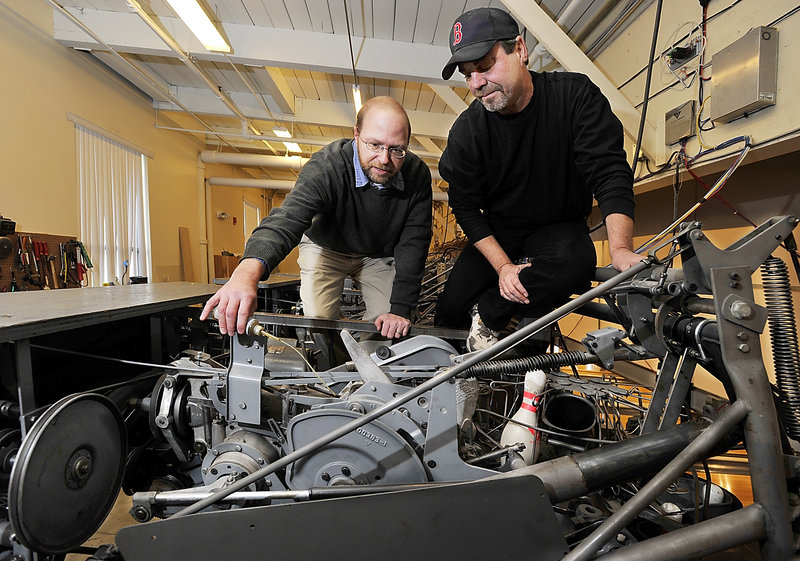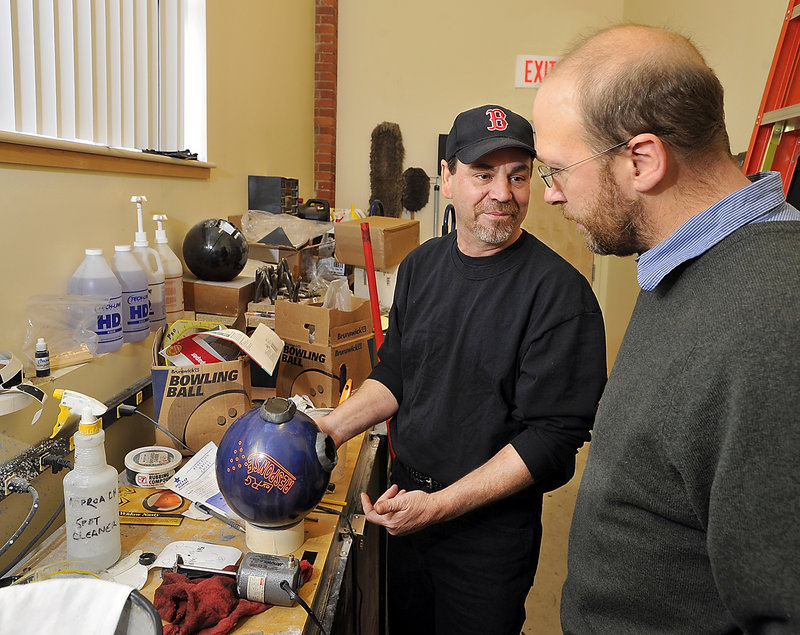PORTLAND – When Steve Closuit said the first chore of the day was to lubricate the pin setters at Bayside Bowl, I envisioned those little racks that come down and pick the pins neatly up off the lane.
But I soon learned that that’s only part of the pin-setting machine. When Closuit took me into the area behind the pins — the area the public doesn’t see — I was stunned to see 12 massive metal contraptions, each taller than me and as wide as a car. Each has some 17,000 parts. When turned on, each pin setter has its wheels and belts turning, arms pumping, clutches engaged.
All this machinery powers the metal sweep, which sweeps pins out of the alley, as well as the metal contraption that actually stands the pins up, and a giant wheel in the back that carries pins from ground level up to where they can be reset onto the alley.
Closuit, 46, operations manager and chief mechanic at Bayside Bowl, grabbed a small tube of oil with a 6-inch-long, straw-like spout and said we were ready to begin.
“It’ll take me about two hours to do all of these, but let’s start,” said Closuit, of Old Orchard Beach. “Watch yourself — lots of moving parts.”
With that, I stepped up onto a metal crossbar, then a higher one, until I was on top of the pin-setting machine.
LANDING WITH A THUD
As one machine rumbled and hummed inches away from me, I prepared to oil one that was shut off. Closuit pointed me to some metal discs that needed oiling. They were pretty well obscured by other parts. This is why there’s a long, straw-like spout on the oil tube.
So I steadied my hand and tried as best I could to leave a line of oil all the way around the disc.
When I went to step off the machine, I forgot how high up I was and jumped down. I landed with a thud, and Closuit reminded to step down on crossbars. It would be easier on my feet.
Closuit showed some other spots to lubricate: pin-sized holes that he had drilled into a couple of large pieces of metal. I could barely see the holes because they were obscured by belts and more metal parts. I squeezed my hand into the machinery and just barely got the spout to one of the holes. As I squeezed, I noticed the oil was dribbling out of the hole.
“No such thing as too much oil,” said Closuit. “This is all metal, nuts and bolts; we want to keep everything running smoothly.”
But at one point, when I climbed down from a machine after oiling it, I found out that what Closuit said was not strictly true. There was such a thing as too much oil — for my pants, at least. I now had a big black splotch on my tan khakis.
“That’s why I always dress in black,” said Closuit.
BUILT IN 1960S — TO LAST
The pin setters get a lot of use. Closuit said that on one day at Bayside recently, there were 599 games bowled on the 12 lanes.
Closuit, who has been maintaining and repairing bowling alley equipment for more than 20 years, said he likes Bayside’s pin setters because they are all metal, nuts and bolts. They were built in the 1960s, and with the proper care, continue to run great, he said.
He compared them to the engine of an older car, where you can see how everything works together.
In contrast, newer pin setting machines are made of plastic. Closuit cringed a little when he told me this.
“I was always the kind of kid who wanted to open things up and see how they work — lawn mowers, engines, anything,” he said. “So when I was first introduced to these things, I was fascinated. And I still learn something new every day.”
Some days, Closuit runs a lane-cleaning machine up and down the wooden lanes to condition the surface. But on this day Bayside had a party of bowlers coming in at noon, so there wasn’t time.
Closuit is also in charge of all the mechanical workings at the alley, so when I first met with him, he was fixing a clog in the drain of the dishwasher. Later, he showed me the room in the back where he takes care of bowling balls. Bayside is a 10-pin alley, meaning it uses the big balls, with holes for your fingers.
Closuit had just finished putting epoxy in the holes of a bowling ball. He was about to grind and sand the ball down and drill new holes in a different spot for a new grip.
Closuit’s not just a fixer of things, he’s done some pro bowling, and has perfect games to his credit.
So for him, keeping the pin setters humming and helping a bowler find a new grip are all part of the same thing — preserving a game he loves.
“For me, I love dealing with people and I love the fact that what we do here helps people have a good time,” he said.
Staff Writer Ray Routhier can be contacted at 791-6454 or at:
rrouthier@pressherald.com
Send questions/comments to the editors.




